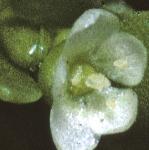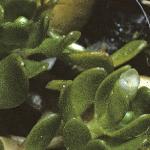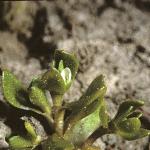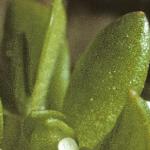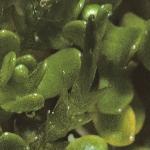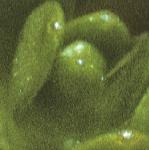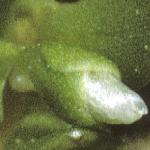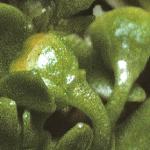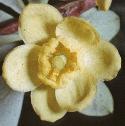|
|
|
|
Flower in June |
Foliage in June |
Form from Teesdale on 29 May |
|
Common Name |
Blinks from Purslane Family |
||
Botanical Name |
Montia fontana (Syn. Montia minor, Montia fontana chondrosperma) |
||
Soil |
Stream-sides, springs, flushes, wet places amongst rocks, moist pastures not on chalk (calcareous) substrata; also in arable fields in South-West England. Common in Southern England |
||
Sun Aspect |
Full Sun |
||
Soil Moisture |
Wet |
||
Plant Type |
Small, normally prostrate, pale green waterweed, often developing into a thick cushion, with stems sometimes reddish in annual land form. It is weaker, decumbent and rooting below in the often biennial to perennial aquatic form which have non-flowering as well as flowering shoots; sometimes floating. |
||
Height x Spread in inches (cms) |
12 x 12 (30 x 30) |
||
Foliage |
Opposite, somewhat fleshy, narrowly spathulate to obovate, narrowed below into stalk-like base, pale green leaves |
||
Flower Colour in Month(s). Fruit |
Tiny White, in clusters towards the end of the stems, on short stalks which lengthen in fruit and are finally erect in May-October followed by roundish fruits |
||
Comment |
Native UK plant. Available from B and T World Seeds |
||
|
|
|
|
Flowers |
Single Leaf from Teesdale on 29 May |
Juvenile Foliage from Widdybank Fell in June |
|
|
|
|
|
Flower Bud Closed from Widdybank Fell in June |
Flower Bud Open from Widdybank Fell in June |
Seed Capsules from Widdybank Fell in June |
|
|
|||
BROWN WILD FLOWER GALLERY PAGE MENUS |
Botanical Name with Common Name, Wild Flower Family, Flower Colour and Form Index of each of all the Wildflowers of the UK in 1965:- AC, AG,AL,AL,AN, Extra Botanical Names have been added within a row for a different plant. Each Extra Botanical Name Plant will link to an Extras Page where it will be detailed in its own row. EXTRAS 91, |
CREAM WILD FLOWER GALLERY PAGE MENUS |
Extra Common Names have been added within a row for a different plant. Each Extra Common Name Plant will link to an Extras Page where it will be detailed in its own row. |
UKButterflies Larval Foodplants website page lists the larval foodplants used by British butterflies. The name of each foodplant links to a Google search. An indication of whether the foodplant is a primary or secondary food source is also given. Please note that the Butterfly you see for only a short time has grown up on plants as an egg, caterpillar and chrysalis for up to 11 months, before becoming a butterfly. If the plants that they live on during that time are removed, or sprayed with herbicide, then you will not see the butterfly. |
||||
Plants used by the Butterflies follow the Plants used by the Egg, Caterpillar and Chrysalis as stated in |
||||
Plant Name |
Butterfly Name |
Egg/ Caterpillar/ Chrysalis/ Butterfly |
Plant Usage |
Plant Usage Months |
Egg, |
1 egg under leaf. |
10 days in May-June |
||
Egg, |
Eggs laid in batches encircling the branch of the food plant. |
Hatches after 18-22 days in April. |
||
Egg, |
Groups of eggs on upper side of leaf. |
- |
||
Egg, |
1 egg at base of plant. |
Late August-April |
||
Egg, |
Groups of eggs on upper side of leaf. |
- |
||
Egg, |
1 egg laid on underside of leaflets or bracts. |
7 days in June. |
||
Egg, |
1 egg laid on underside of leaflets or bracts. |
7 days in June. |
||
Egg, |
1 egg laid under the leaf or on top of the flower. |
7 days in August. |
||
Egg, |
1 egg on underside of a flower bud on its stalk. |
7 days. |
||
Egg, |
1 egg on underside of a flower bud on its stalk. |
7 days. |
||
Egg, |
1 egg under leaf. |
10 days in May-June. |
||
Egg, |
1 egg on leaf. |
2 weeks |
||
Cabbages - Large White eats all cruciferous plants, such as cabbages, mustard, turnips, radishes, cresses, nasturtiums, wild mignonette and dyer's weed |
Egg,
|
40-100 eggs on both surfaces of leaf. |
May-June and August-Early September. 4.5-17 days. |
|
Egg, |
1 egg on underside of leaf. |
May-June and August. 7 days. |
||
Cabbages:- |
Egg, |
1 egg on underside of leaf. |
July or August; hatches in 3 days. |
|
Cabbages:- |
Egg, |
1 egg laid in the tight buds and flowers. |
May-June 7 days. |
|
Cherry with |
Egg, |
Eggs laid in batches encircling the branch of the food plant. |
Hatches after 18-22 days in April. |
|
Egg, |
Groups of eggs on upper side of leaf. |
- |
||
Egg, |
1 egg on leaf. |
10 days in May-June. |
||
Egg, |
1 egg on leaf. |
6 days in May-June. |
||
Egg, |
1 egg under leaf. |
|
||
|
(Common CowWheat, Field CowWheat) |
Egg, |
Eggs laid in batches on the under side of the leaves. |
Hatches after 16 days in June. |
|
Currants |
Egg, |
Groups of eggs on upper side of leaf. |
|
|
Egg, |
Eggs laid in batches on the under side of the leaves. |
Hatches after 20 days in July. |
||
Dog Violet with |
Egg, |
1 egg on oak or pine tree trunk |
15 days in July. |
|
Dog Violet with |
Egg, |
1 egg on leaf or stem. |
Hatches after 15 days in May-June. |
|
Dog Violet with |
Egg, |
1 egg on leaf or stem. |
Hatches after 10 days in May-June. |
|
Egg, |
1 egg on underside of a flower bud on its stalk. |
7 days. |
||
Egg, |
Eggs laid in batches encircling the branch of the food plant. |
Hatches after 18-22 days in April. |
||
False Brome is a grass (Wood Brome, Wood False-brome and Slender False-brome) |
Egg, |
1 egg under leaf. |
... |
|
Egg, |
Eggs laid in batches on the under side of the leaves. |
Hatches after 20 days in July. |
||
Egg, |
1 egg laid on underside of leaflets or bracts. |
7 days in June. |
||
Egg, |
1 egg on leaf or stem. |
Hatches after 10 days in May-June. |
||
Egg, |
1 egg on underside of a flower bud on its stalk. |
7 days. |
||
Egg, |
1 egg laid under the leaf or on top of the flower. |
7 days in August. |
||
Egg, |
1 egg on leaf. 5 or 6 eggs may be deposited by separate females on one leaf. |
14 days in July-August. |
||
Egg, |
1 egg on underside of a flower bud on its stalk. |
7 days. |
||
Egg, |
1 egg laid in the tight buds and flowers. |
May-June 7 days. |
||
Egg, |
Eggs laid in batches on the under side of the leaves. |
Hatches after 20 days in July. |
||
Egg, |
Groups of eggs on upper side of leaf. |
|
||
Egg, |
1 egg under leaf. |
1 then |
||
Egg, |
1 egg on underside of a flower bud on its stalk. |
7 days. |
||
Egg, |
1 egg at base of plant. |
Late August-April. |
||
Egg, |
1 egg on leaf. |
10 days in May-June. |
||
Egg, |
1 egg on leaf. |
2 weeks |
||
Egg, |
1 egg on leaf. |
6 days in May-June. |
||
Egg, |
1 egg on underside of leaf. |
May-June and August. 7 days. |
||
Egg, |
1 egg on leaf. 5 or 6 eggs may be deposited by separate females on one leaf. |
14 days in July-August. |
||
Narrow-leaved Plantain (Ribwort Plantain) |
Egg, |
Eggs laid in batches on the under side of the leaves. |
Hatches after 16 days in June. |
|
Narrow-leaved Plantain (Ribwort Plantain) |
Egg, |
Eggs laid in batches on the under side of the leaves. |
Hatches after 16 days in June. |
|
Nasturtium from Gardens |
Egg, |
1 egg on underside of leaf. |
May-June and August. 7 days. |
|
Egg, |
1 egg on tree trunk |
15 days in July. |
||
Mountain pansy, |
Egg, Chrysalis |
1 egg laid under the leaf or on top of the flower. |
7 days in August. 3 weeks in September |
|
Egg, |
1 egg on tree trunk. |
15 days in July. |
||
Egg, |
Eggs laid in batches on the under side of the leaves. |
Hatches after 20 days in July. |
||
Egg, |
Eggs laid in batches encircling the branch of the food plant. |
Hatches after 18-22 days in April. |
||
Egg, |
Groups of eggs on upper side of leaf. |
- |
||
Egg, |
1 egg under leaf. |
|
||
Egg, |
1 egg laid under the leaf or on top of the flower. |
7 days in August. |
||
Egg, |
Eggs laid in batches encircling the branch of the food plant. |
Hatches after 18-22 days in April. |
||
Egg, |
Eggs laid in batches on the under side of the leaves. |
Hatches after 16 days in June. |
||
Egg, |
1 egg on underside of a flower bud on its stalk. |
7 days. |
||
Egg, |
1 egg on underside of a flower bud on its stalk. |
7 days. |
||
Egg, |
Groups of eggs on upper side of leaf. |
|
||
Egg, |
1 egg under leaf. |
|
||
Egg, |
1 egg on leaf. |
2 weeks |
||
Trefoils 1, 2, 3 |
Egg, |
1 egg on leaf. |
6 days in May-June. |
|
Egg, |
Groups of eggs on upper side of leaf. |
- |
||
Egg, |
1 egg laid on underside of leaflets or bracts. |
7 days in June. |
||
Violets:- |
Egg, |
1 egg on underside of leaf or on stalk. |
July-August for 17 days. |
|
Violets:- |
Egg, |
1 egg on stem or stalk near plant base. |
July to hatch in 8 months in March. |
|
Egg, |
1 egg on leaf. |
2 weeks. |
||
Egg, |
Eggs laid in batches encircling the branch of the food plant. |
Hatches after 18-22 days in April. |
||
Egg, |
1 egg on leaf. 5 or 6 eggs may be deposited by separate females on one leaf. |
14 days in July-August. |
||
Willow |
Egg, |
Eggs laid in batches encircling the branch of the food plant. |
Hatches after 18-22 days in April. |
|
Egg, |
Eggs laid in batches on the under side of the leaves. |
Hatches after 20 days in July. |
||
Plants used by the Butterflies |
||||
Plant Name |
Butterfly Name |
Egg/ Caterpillar/ Chrysalis/ Butterfly |
Plant Usage |
Plant Usage Months |
Asters |
Butterfly |
Eats nectar. |
|
|
Runner and Broad Beans in fields and gardens |
Butterfly |
Eats nectar |
April-June or July-September. |
|
Aubretia in gardens |
Butterfly |
Eats nectar |
May-June or August till killed by frost and damp in September-November |
|
Butterfly |
Eats sap exuding from trunk. |
April-Mid June and Mid July-Early September for second generation. |
||
Butterfly |
Eats nectar. |
20 days. |
||
Butterfly |
Eats nectar |
May-June |
||
Holly Blue |
Butterfly |
Eats nectar |
April-Mid June and Mid July-Early September for second generation. |
|
Butterfly |
Eats nectar. |
July-October. |
||
Buddleias |
Butterfly |
Eats nectar. |
July-October. |
|
Wood White |
Butterfly |
Eats nectar |
May-June. |
|
Cabbage and cabbages in fields |
Butterfly |
Eats nectar |
April-June or July-September. |
|
Butterfly |
Eats nectar |
July-October |
||
Adonis Blue |
Butterfly |
Eats nectar. |
1 Month during Mid-May to Mid-June or during August-September |
|
Pale Clouded Yellow |
Butterfly |
Eats nectar |
May-June or August till killed by frost and damp in September-November |
|
Cow-wheat |
Butterfly |
Eats nectar |
June-July |
|
Butterfly |
Eats nectar |
May-June |
||
Butterfly |
Eats nectar |
April-Mid June and Mid July-Early September for second generation. |
||
Butterfly |
Eats nectar. |
3 weeks between May and September |
||
Germander Speedwell (Veronica chamaedrys - Birdseye Speedwell) |
Butterfly |
Eats nectar |
June-July |
|
Butterfly |
Eats nectar. |
July-October. |
||
Butterfly |
Eats nectar |
30 days in May-June. |
||
Butterfly |
Eats nectar |
May-September |
||
Butterfly |
Eats nectar. |
May-June for 18 days. |
||
Butterfly |
Eats nectar. |
July-October |
||
Butterfly |
Eats nectar. |
1 Month. |
||
Butterfly |
Eats nectar. |
July-October. |
||
Painted Lady |
Butterfly |
Eats nectar |
July-October. |
|
Marigolds in gardens |
Butterfly |
Eats nectar |
May-June or August till killed by frost and damp in September-November |
|
Butterfly |
Eats nectar. |
1 Month during Mid-May to Mid-June or during August-September. |
||
Michaelmas Daisies |
Butterfly |
Eats nectar. |
July-October |
|
Butterfly |
Eats nectar |
April-June or July-September. |
||
Narrow-leaved Plantain (Ribwort Plantain) |
Butterfly |
Eats nectar |
June-July |
|
Nasturtiums in gardens |
Butterfly |
Eats nectar |
April-June or July-September |
|
Butterfly |
Eats sap exuding from trunk. |
April-Mid June and Mid July-Early September for second generation. |
||
Butterfly |
Eats nectar |
June. |
||
Butterfly |
Eats nectar |
May-June. |
||
Butterfly |
Eats nectar |
July-October. |
||
Butterfly |
Eats nectar |
July-May |
||
Butterfly |
Eats nectar |
7 weeks in July-August. |
||
Comma |
Butterfly |
Eats nectar. |
July-October. |
|
Butterfly |
Eats nectar. |
3 weeks between May and September |
||
Trefoils 1, 2, 3 |
Butterfly |
Eats nectar. |
1 Month during Mid-May to Mid-June or during August-September |
|
Butterfly |
Eats nectar. |
20 days in August. |
||
Butterfly |
Eats nectar |
June.
|
||
Butterfly |
Eats nectar |
June-July |
||
Apple/Pear/Cherry/Plum Fruit Tree Blossom in Spring |
Butterfly |
Eats Nectar |
April-May |
|
Rotten Fruit |
Butterfly |
Drinks juice |
July-September |
|
Tree sap and damaged ripe fruit, which are high in sugar |
Butterfly |
Hibernates inside hollow trees or outhouses until March. Eats sap or fruit juice until April. |
10 months in June-April |
|
Wild Flowers |
Large Skipper |
Butterfly |
Eats Nectar |
June-August |
Links to the other Butterflies:- Black Hairstreak |
Topic - Wildlife on Plant Photo Gallery. Some UK native butterflies eat material from UK Native Wildflowers and live on them as eggs, caterpillars (Large Skipper eats False Brome grass - Brachypodium sylvaticum - for 11 months from July to May as a Caterpillar before becoming a Chrysalis within 3 weeks in May) chrysalis or butterflies ALL YEAR ROUND. |
Wild Flower Family Page (the families within "The Pocket Guide to Wild Flowers" by David McClintock & R.S.R. Fitter, Published in 1956 They are not in Common Name alphabetical order and neither are the common names of the plants detailed within each family. The information in the above book is back-referenced to the respective page in "Flora of the British Isles" by A.R. Clapham of University of Sheffield, |
||
My Comments about the proposed Cobtree Manor Park is where I and my friend used to take her dog for a 2 hour walk every week. See Map Cobtree Manor Park and Cobtree Manor 18 hole Public Golf Course (1golf.eu picture shows the golf course with its fairways to the left of the point 2/3rds across the picture from the left, with 2 grassed areas dotted with trees behind a hedge of trees above that golf course - that area is where people walk their dogs) occupy 50 acres of parkland displaying a diverse and maturing collection of trees and shrubs. I would be surprised if Cobtree Manor Park grassed area occupied more than 6 of those 50 acres. The Park Ranger and Maidstone Borough Council have decided that every dog will be put on a lead at this public place with no method of allowing that dog any exercise unless the owners can run with the dog under their byelaws of 1998. Cobtree Manor Park
My Comments The proposed rerouting of the Bridle Path would also disturb the declining numbers of Great Crested Newts who use that pond. Since there have only been 2 visitors to this site who have emailed me in the last 2 years, the above comments may be a waste of time, since written comments on paper to the Cobtree Officer Brian Latimer or emailed to him at brianlatimer@maidstone.gov.uk must be in by Friday 16th April 2010 and not emailed to me.
---------
The following is an excerpt from my Comments about the proposed destruction of the wildlife habitats at Cobtree Manor Park in the summer of 2010 from the bottom part of my Mission Statement page "We would be sorry to lose the butterflies on the bluebells, bramble and ivy that would be restricted to only the very small area of proposed Wildlife Meadow by the Woods at the bottom of a hill with water springs on it. The wildlife is now being excluded from all the other areas by the "pruning", so that the nettles, brambles etc which had for instance the butterfly life cycle included; are now being ruthlessly removed to create a garden, not a park, with neat little areas." The life and death of a flailed cornish hedge was repeated at Cobtree Manor Park,
When you look at the life history graphs of each of the 68 butterflies of Britain, you will see that they use plants throughout all 12 months - the information of what plant is used by the egg, caterpillar, chrysalis or butterfly is also given in the above first column.
---------
THE LIFE AND DEATH OF A FLAILED CORNISH HEDGE - This details that life and death from July 1972 to 2019, with the following result:- End note, June 2008. I hear spring vetch has been officially recorded somewhere in West Cornwall and confirmed as a presence in the county, so perhaps I can be permitted to have seen it pre-1972 in the survey mile. I wonder where they found it? It's gone from hedges where it used to be, along with other scarcities and so-called scarcities that used to flourish in so many hedges unrecorded, before the flail arrived. I have given careful thought to including mention of some of the plants and butterflies. So little seems to be known of the species resident in Cornish hedges pre-flail that I realise some references may invite scepticism. I am a sceptic myself, so sympathise with the reaction; but I have concluded that, with a view to re-establishing vulnerable species, it needs to be known that they can with the right management safely and perpetually thrive in ordinary Cornish hedges. In future this knowledge could solve the increasingly difficult question of sufficient and suitable sites for sustainable wild flower and butterfly conservation - as long as it is a future in which the hedge-flail does not figure.
CHECK-LIST OF TYPES OF CORNISH HEDGE FLORA by Sarah Carter of Cornish Hedges Library:-
Titles of papers available on www.cornishhedges.co.uk:-
THE GUILD OF CORNISH HEDGERS is the non-profit-making organisation founded in 2002 to support the concern among traditional hedgers about poor standards of workmanship in Cornish hedging today. The Guild has raised public awareness of Cornwall's unique heritage of hedges and promoted free access to the Cornish Hedges Library, the only existing source of full and reliable written knowledge on Cornish hedges." |
||||
Copied from Ivydene Gardens Blue Wildflowers Note Gallery: |
|||||||||||||||||||||||||||||||||||||||||||||||||||||||||||||||||||||||||||||||||||||||||||||||
Plant Height from Text Border |
Blue = 0-24 inches (0-60 cms) |
Green=24-72 inches (60-180 cms) |
Red = 72+ inches (180+ cms) |
||||||||||||||||||||||||||||||||||||||||||||||||||||||||||||||||||||||||||||||||||||||||||||
Plant Soil Moisture from Text Background |
Wet Soil |
Moist Soil |
Dry Soil |
||||||||||||||||||||||||||||||||||||||||||||||||||||||||||||||||||||||||||||||||||||||||||||
Click on thumbnail to change this comparison page to the Plant Description Page of the plant named in the Text box below the photo. |
|||||||||||||||||||||||||||||||||||||||||||||||||||||||||||||||||||||||||||||||||||||||||||||||
|
|
|
|
|
|
|
|
||||||||||||||||||||||||||||||||||||||||||||||||||||||||||||||||||||||||||||||||||||||||
BUTTER-CUP Celery-Leaved Butter-cup |
BUTTER-CUP Globe Flower HAY MEAD-OWS, RIVER BANKS, LAKE MARG-INS, OPEN WOOD-LAND |
BUTTER-CUP Jersey Butter-cup GRASS-LAND - WET IN WINTER, SUN-BAKED IN SUMMER. DIES DOWN AFTER IT FLOWERS |
BUTTER-CUP Lesser Celan-dine WOODS, MARI-TIME GRASS-LAND, RIVER BANKS, ROAD-SIDES Mar-May |
BUTTER-CUP Lesser Spear-wort Jun- onwards |
BUTTER-CUP Marsh Marigold EDGES OF RIVERS, LAKES, WINTER-WET MEAD-OWS Mar-Jun |
BUTTER-CUP Small-flowered Butter-cup May-Jul |
BUTTER-CUP Bulbous Butter-cup CHALKY SOILS IN MEAD-OWS, PAST-URES AND DUNES Mar-Jun |
||||||||||||||||||||||||||||||||||||||||||||||||||||||||||||||||||||||||||||||||||||||||
|
|
|
|
|
|
|
|
||||||||||||||||||||||||||||||||||||||||||||||||||||||||||||||||||||||||||||||||||||||||
BUTTER-CUP Winter Aconite OPEN WOOD-LAND, GARD-ENS AND ROAD VERGES. DIES BACK IN SUMMER Jan-Mar |
BUTTER-CUP |
FUMIT-ORY Yellow Corydalis OLD WALLS, BRICK RUBBLE AND STONY WASTE GROUND May-Aug |
CRUCIF-ER Charlock WEED May - onwards |
CRUCIF-ER Common Winter-cress May-Jul |
CRUCIF-ER Creeping Yellow Cress SITES FLOODED IN WINTER, EDGES OF RIVERS, DITCHES Jun - onwards |
CRUCIF-ER May - onwards |
CRUCIF-ER Mar-Jun |
||||||||||||||||||||||||||||||||||||||||||||||||||||||||||||||||||||||||||||||||||||||||
|
|
|
|
|
|
|
|
||||||||||||||||||||||||||||||||||||||||||||||||||||||||||||||||||||||||||||||||||||||||
CRUCIF-ER Mar-Apr |
POPPY Greater Celand-ine ROAD-SIDES, PATHS, IN THE CREV-ICES OF OLD WALLS, HEDGE-BOTTOM May-Sep |
POPPY Jun-Aug |
POPPY Jun-Sep |
VIOLET Hearts-ease DUNES, OTHER SANDY AREAS ON ACIDIC GRASS-LAND AND GARDENS Apr - onwards |
BUTTER-CUP Creep-ing Butter-cup WOOD-LAND RIDES, FARM GATE-WAYS, GARDENS May - onwards |
SAINT JOHNS WORT Common Saint John's Wort CHALKY SOIL IN HEDGE-BANKS, WOODS, GRASS-LAND Jul - onwards |
SAINT JOHNS WORT Elegant Saint John's Wort HEATH, DECID-UOUS WOOD-LAND, HEDGE-ROWS Poison-ous |
||||||||||||||||||||||||||||||||||||||||||||||||||||||||||||||||||||||||||||||||||||||||
|
|
|
|
|
|
|
|
||||||||||||||||||||||||||||||||||||||||||||||||||||||||||||||||||||||||||||||||||||||||
WATER-LILY Yellow Water-lily LAKES, PONDS, PONDS IN GARDENS Jun-Sep |
BUTTER-CUP Greater Spear-wort |
BUTTER-CUP Lesser Meadow-rue CALCA-REOUS FIXED DUNES, CLIFFS, LIME-STONE, LIME-STONE GRASS-LAND |
BUTTER-CUP Meadow Butter-cup DAMP MEAD-OWS, UNIMP-ROVED WATER-MEADOW DUNE GRASS-LAND |
CRUCIF-ER American Land-cress GARDEN ESCAPE BY ROADS AND ON RAIL-WAYS Apr-Jul |
CRUCIF-ER Barge-man's Cabbage RIVER AND CANAL BANKS, ROAD-SIDES, ARABLE FIELDS, TIPS Apr- onwards |
CRUCIF-ER May-onwards |
CRUCIF-ER Jun-Aug |
||||||||||||||||||||||||||||||||||||||||||||||||||||||||||||||||||||||||||||||||||||||||
|
|
|
|
|
|
|
|
||||||||||||||||||||||||||||||||||||||||||||||||||||||||||||||||||||||||||||||||||||||||
CRUCIF-ER May- onwards |
CRUCIF-ER Jun-Aug |
IRIS Yellow Flag Jun-Aug |
MIGNO-NETTE Wild Migno-nette WELL-DRAINED SOILS ON ROAD-SIDE VERGES, QUAR-RIES June- onwards |
PRIM-ROSE Jul-Aug |
SAINT JOHNS WORT Hairy Saint John's Wort WOOD-LAND, HEDGE-ROWS, RIVER-BANKS ON CHALK, CLAY |
SAINT JOHNS WORT Tutsan SHADED WOODS, HEDGE-ROWS. Seed spread by Birds. Poison-ous Jun-Aug |
BAR-BERRY Oregon Grape EVER-GREEN SHRUB IN HEDGE-ROWS, ROAD VERGES, WOOD-LAND Mar-May |
||||||||||||||||||||||||||||||||||||||||||||||||||||||||||||||||||||||||||||||||||||||||
|
|
|
|
|
|
|
|
||||||||||||||||||||||||||||||||||||||||||||||||||||||||||||||||||||||||||||||||||||||||
CRUCIF-ER May-Aug |
|
|
|
|
|
|
|
||||||||||||||||||||||||||||||||||||||||||||||||||||||||||||||||||||||||||||||||||||||||
|
|
|
|
|
|
|
|
||||||||||||||||||||||||||||||||||||||||||||||||||||||||||||||||||||||||||||||||||||||||
BAR-BERRY Barberry DECID-UOUS SHRUB IN HEDGE-ROWS, COP-PICES. BANKS, CLIFFS May-Jun |
|
|
|
|
|
|
|
||||||||||||||||||||||||||||||||||||||||||||||||||||||||||||||||||||||||||||||||||||||||
|
|
|
|
|
|
|
|
||||||||||||||||||||||||||||||||||||||||||||||||||||||||||||||||||||||||||||||||||||||||
Site design and content copyright ©January 2016. Photos and other details added February 2017. Chris Garnons-Williams. DISCLAIMER: Links to external sites are provided as a courtesy to visitors. Ivydene Horticultural Services are not responsible for the content and/or quality of external web sites linked from this site. |
Marjorie Blamey's Wild Flowers by Colour by Marjorie Blamey (ISBN 0-7136-7237-4. Published by A & C Black Publishers Ltd in 2005) has illustrations of each wild flower of Britain and Northern Europe split into the following 13 colours. Instead of colour illustrations, this plant gallery has thumbnail pictures of wild flowers of Britain in the same colour split system:-
|
||||||||||||||||||||||||||||||||||||||||||||||||||||||||||||||||||||||||||||||||||||||||||||||
Form from
Form for Wildflowers:- Mat-forming These Forms are used for Bulbs with Herbaceous and Evergreen Perennials.
Shape for Evergreen Shrubs:- These Forms and Shapes are also used for Deciduous and Evergreen Shrubs and Trees. |
|||||||||||||||||||||||||||||||||||||||||||||||||||||||||||||||||||||||||||||||||||||||||||||||
Wildflowers with Yellow Flowers |
|||||||||||||||||||||||||||||||||||||||||||||||||||||||||||||||||||||||||||||||||||||||||||||||
Wildflower Common Plant Name Click on Underlined Text
Flower Photo Flowers Photo Foliage Photo Form Photo
|
Flowering Months Click on Underlined Text |
Habitat Click on Underlined Text
Native in:- |
Number of Petals Without Petals. |
Foliage Colour |
Height x Spread in inches (cms) (1 inch = 2.5 cms, |
Comment Click on Underlined Botanical Name
See illustration
Botanical Name |
|||||||||||||||||||||||||||||||||||||||||||||||||||||||||||||||||||||||||||||||||||||||||
Agrimony |
|
|
|
|
|
|
|||||||||||||||||||||||||||||||||||||||||||||||||||||||||||||||||||||||||||||||||||||||||
|
|
|
|
|
|
||||||||||||||||||||||||||||||||||||||||||||||||||||||||||||||||||||||||||||||||||||||||||
|
|
|
|
|
|
||||||||||||||||||||||||||||||||||||||||||||||||||||||||||||||||||||||||||||||||||||||||||
Annual Yellow Woundwort |
|
|
|
|
|
|
|||||||||||||||||||||||||||||||||||||||||||||||||||||||||||||||||||||||||||||||||||||||||
Arnica |
|
|
|
|
|
|
|||||||||||||||||||||||||||||||||||||||||||||||||||||||||||||||||||||||||||||||||||||||||
Artemesia pontica |
|
|
|
|
|
|
|||||||||||||||||||||||||||||||||||||||||||||||||||||||||||||||||||||||||||||||||||||||||
Autumn Hawkbit |
|
|
|
|
|
|
|||||||||||||||||||||||||||||||||||||||||||||||||||||||||||||||||||||||||||||||||||||||||
A deciduous shrub found in hedgerows and coppices, and on banks, cliffs and waste ground. Generally lowland, but reaching 395 m on Wanthwaite Crags (Cumberland). |
6 Petals |
Dark Green with Light Grey under-side |
Pollinated by various insects. |
Provides red berries for the birds to eat in the autumn. |
|||||||||||||||||||||||||||||||||||||||||||||||||||||||||||||||||||||||||||||||||||||||||||
|
|
|
|
|
|
||||||||||||||||||||||||||||||||||||||||||||||||||||||||||||||||||||||||||||||||||||||||||
Beaked Hawk's-beard |
|
|
|
|
|
|
|||||||||||||||||||||||||||||||||||||||||||||||||||||||||||||||||||||||||||||||||||||||||
Bedstraw Broomrape |
|
|
|
|
|
|
|||||||||||||||||||||||||||||||||||||||||||||||||||||||||||||||||||||||||||||||||||||||||
Beggarticks |
|
|
|
|
|
|
|||||||||||||||||||||||||||||||||||||||||||||||||||||||||||||||||||||||||||||||||||||||||
Belgian Gagea |
|
|
|
|
|
|
|||||||||||||||||||||||||||||||||||||||||||||||||||||||||||||||||||||||||||||||||||||||||
Bidens radiata |
|
|
|
|
|
|
|||||||||||||||||||||||||||||||||||||||||||||||||||||||||||||||||||||||||||||||||||||||||
Black-eyed Susan |
|
|
|
|
|
|
|||||||||||||||||||||||||||||||||||||||||||||||||||||||||||||||||||||||||||||||||||||||||
|
|
|
|
|
|
||||||||||||||||||||||||||||||||||||||||||||||||||||||||||||||||||||||||||||||||||||||||||
Bladderwort |
|
|
|
|
|
|
|||||||||||||||||||||||||||||||||||||||||||||||||||||||||||||||||||||||||||||||||||||||||
Blood-drop Emlets |
|
|
|
|
|
|
|||||||||||||||||||||||||||||||||||||||||||||||||||||||||||||||||||||||||||||||||||||||||
Bog Asphodel |
|
|
|
|
|
|
|||||||||||||||||||||||||||||||||||||||||||||||||||||||||||||||||||||||||||||||||||||||||
Bohemian Gagea |
|
|
|
|
|
|
|||||||||||||||||||||||||||||||||||||||||||||||||||||||||||||||||||||||||||||||||||||||||
Bombycilaena erecta |
|
|
|
|
|
|
|||||||||||||||||||||||||||||||||||||||||||||||||||||||||||||||||||||||||||||||||||||||||
Broad-leaved Ragwort |
|
|
|
|
|
|
|||||||||||||||||||||||||||||||||||||||||||||||||||||||||||||||||||||||||||||||||||||||||
Bristly Oxtongue |
|
|
|
|
|
|
|||||||||||||||||||||||||||||||||||||||||||||||||||||||||||||||||||||||||||||||||||||||||
A perennial herb with a corm-like stem-base, found on well-drained, neutral or calcareous soils in meadows, pastures and dunes. It is absent from highly productive, fertile grassland and from strongly acidic soils. |
5 Petals Pollinated by various insects, especially hover flies and small bees. |
Mid-green |
16 x 12 (40 x 30) |
Avoided by grazing animals but intolerant of trampling. |
|||||||||||||||||||||||||||||||||||||||||||||||||||||||||||||||||||||||||||||||||||||||||||
Buttonweed |
|
|
|
|
|
|
|||||||||||||||||||||||||||||||||||||||||||||||||||||||||||||||||||||||||||||||||||||||||
Cabbage Thistle |
|
|
|
|
|
|
|||||||||||||||||||||||||||||||||||||||||||||||||||||||||||||||||||||||||||||||||||||||||
Canadian Goldenrod |
|
|
|
|
|
|
|||||||||||||||||||||||||||||||||||||||||||||||||||||||||||||||||||||||||||||||||||||||||
|
|
|
|
|
|
||||||||||||||||||||||||||||||||||||||||||||||||||||||||||||||||||||||||||||||||||||||||||
Cat's-ear |
|
|
|
|
|
|
|||||||||||||||||||||||||||||||||||||||||||||||||||||||||||||||||||||||||||||||||||||||||
Most Poisonous member of genus Ranunculus. An annual of shallow water or wet, disturbed, nutrient-rich mud, especially at the edges of ponds, ditches, streams or rivers which are poached by drinking livestock. It is salt-tolerant and frequent on grazed estuarine marshes. Its seeds are long-lived and plants can re-appear following disturbance after many years of absence. |
5 Petals Visited by flies |
Pale green |
24 x 12 (60 x 30) |
|
|||||||||||||||||||||||||||||||||||||||||||||||||||||||||||||||||||||||||||||||||||||||||||
|
|
|
|
|
|
||||||||||||||||||||||||||||||||||||||||||||||||||||||||||||||||||||||||||||||||||||||||||
Chondrilla |
|
|
|
|
|
|
|||||||||||||||||||||||||||||||||||||||||||||||||||||||||||||||||||||||||||||||||||||||||
Coltsfoot |
|
|
|
|
|
|
|||||||||||||||||||||||||||||||||||||||||||||||||||||||||||||||||||||||||||||||||||||||||
Common Broomrape |
|
|
|
|
|
|
|||||||||||||||||||||||||||||||||||||||||||||||||||||||||||||||||||||||||||||||||||||||||
Common Cow-wheat |
|
|
|
|
|
|
|||||||||||||||||||||||||||||||||||||||||||||||||||||||||||||||||||||||||||||||||||||||||
Common Cudweed |
|
|
|
|
|
|
|||||||||||||||||||||||||||||||||||||||||||||||||||||||||||||||||||||||||||||||||||||||||
Common Fleabane |
|
|
|
|
|
|
|||||||||||||||||||||||||||||||||||||||||||||||||||||||||||||||||||||||||||||||||||||||||
Common Hawkweed |
|
|
|
|
|
|
|||||||||||||||||||||||||||||||||||||||||||||||||||||||||||||||||||||||||||||||||||||||||
Common Ragwort |
|
|
|
|
|
|
|||||||||||||||||||||||||||||||||||||||||||||||||||||||||||||||||||||||||||||||||||||||||
|
|
|
|
|
|
||||||||||||||||||||||||||||||||||||||||||||||||||||||||||||||||||||||||||||||||||||||||||
|
|
|
|
|
|
||||||||||||||||||||||||||||||||||||||||||||||||||||||||||||||||||||||||||||||||||||||||||
Common Toadflax |
|
|
|
|
|
|
|||||||||||||||||||||||||||||||||||||||||||||||||||||||||||||||||||||||||||||||||||||||||
|
|
|
|
|
|
||||||||||||||||||||||||||||||||||||||||||||||||||||||||||||||||||||||||||||||||||||||||||
Coneflower |
|
|
|
|
|
|
|||||||||||||||||||||||||||||||||||||||||||||||||||||||||||||||||||||||||||||||||||||||||
Coralroot Orchid |
|
|
|
|
|
|
|||||||||||||||||||||||||||||||||||||||||||||||||||||||||||||||||||||||||||||||||||||||||
Corn Buttercup, |
An annual of arable land on loams, sands, clays and chalk. The seeds are long-lived, and plants sometimes reappear on disturbed waste ground, or in gardens or new roadside verges on former arable land. |
5 Petals |
Pale Green |
6-18 x |
Ranunculus arvensis Visited by small flies. Long established, as a cornfield weed especially on calcareous soils. |
||||||||||||||||||||||||||||||||||||||||||||||||||||||||||||||||||||||||||||||||||||||||||
Corn Marigold |
|
|
|
|
|
|
|||||||||||||||||||||||||||||||||||||||||||||||||||||||||||||||||||||||||||||||||||||||||
Cottonweed |
|
|
|
|
|
|
|||||||||||||||||||||||||||||||||||||||||||||||||||||||||||||||||||||||||||||||||||||||||
Primula veris |
|
|
|
|
|
|
|||||||||||||||||||||||||||||||||||||||||||||||||||||||||||||||||||||||||||||||||||||||||
A perennial herb with creeping stems, R. repens has a very wide ecological tolerance, but is most typical of disturbed habitats on damp or wet nutrient-rich soils, including woodland rides, ditch sides, farm gateways, gardens and waste ground. It also occurs in damp or periodically flooded grasslands, in dune-slacks and on lake shores. It is absent from very acidic soils. |
5 Petals |
Dark Green |
24 x 24 (60 x 60) |
Ranunculus repens Visited by various insects, especially hover flies and small bees. Common in wet meadows, pastures and woods, in dune-slacks and on gravel-heaps, and as a weed in clay |
|||||||||||||||||||||||||||||||||||||||||||||||||||||||||||||||||||||||||||||||||||||||||||
Creeping Comfrey |
|
|
|
|
|
|
|||||||||||||||||||||||||||||||||||||||||||||||||||||||||||||||||||||||||||||||||||||||||
|
|
|
|
|
|
||||||||||||||||||||||||||||||||||||||||||||||||||||||||||||||||||||||||||||||||||||||||||
Creeping Spearwort is Ranunculus reptans |
A stoloniferous perennial herb of lake shores, growing on gravel or silty sand. At the Loch of Strathbeg (N. Aberdeen), where it has been known since 1876, it grows in open vegetation in a zone of Eleocharis palustris which is intermittently exposed above the water level in summer. |
5 Petals |
Dark Green prostrate with arching rooting runners |
2-18 x 6 (5-45 x 15) |
Ranunculus reptans |
||||||||||||||||||||||||||||||||||||||||||||||||||||||||||||||||||||||||||||||||||||||||||
|
|
|
|
|
|
||||||||||||||||||||||||||||||||||||||||||||||||||||||||||||||||||||||||||||||||||||||||||
Crimson-tipped Lousewort |
|
|
|
|
|
|
|||||||||||||||||||||||||||||||||||||||||||||||||||||||||||||||||||||||||||||||||||||||||
Cut-leaved Viper's-grass |
|
|
|
|
|
|
|||||||||||||||||||||||||||||||||||||||||||||||||||||||||||||||||||||||||||||||||||||||||
Dandelion |
|
|
|
|
|
|
|||||||||||||||||||||||||||||||||||||||||||||||||||||||||||||||||||||||||||||||||||||||||
Dark Mullein |
|
|
|
|
|
|
|||||||||||||||||||||||||||||||||||||||||||||||||||||||||||||||||||||||||||||||||||||||||
Dense-flowered Mullein |
|
|
|
|
|
|
|||||||||||||||||||||||||||||||||||||||||||||||||||||||||||||||||||||||||||||||||||||||||
Downy Hemp-nettle |
|
|
|
|
|
|
|||||||||||||||||||||||||||||||||||||||||||||||||||||||||||||||||||||||||||||||||||||||||
Downy Salflower |
|
|
|
|
|
|
|||||||||||||||||||||||||||||||||||||||||||||||||||||||||||||||||||||||||||||||||||||||||
Eastern Groundsel |
|
|
|
|
|
|
|||||||||||||||||||||||||||||||||||||||||||||||||||||||||||||||||||||||||||||||||||||||||
Elder-flowered Orchid |
|
|
|
|
|
|
|||||||||||||||||||||||||||||||||||||||||||||||||||||||||||||||||||||||||||||||||||||||||
Elecampane |
|
|
|
|
|
|
|||||||||||||||||||||||||||||||||||||||||||||||||||||||||||||||||||||||||||||||||||||||||
|
|
|
|
|
|
||||||||||||||||||||||||||||||||||||||||||||||||||||||||||||||||||||||||||||||||||||||||||
|
|
|
|
|
|
||||||||||||||||||||||||||||||||||||||||||||||||||||||||||||||||||||||||||||||||||||||||||
Fen Ragwort |
|
|
|
|
|
|
|||||||||||||||||||||||||||||||||||||||||||||||||||||||||||||||||||||||||||||||||||||||||
|
|
|
|
|
|
||||||||||||||||||||||||||||||||||||||||||||||||||||||||||||||||||||||||||||||||||||||||||
Field Fleawort |
|
|
|
|
|
|
|||||||||||||||||||||||||||||||||||||||||||||||||||||||||||||||||||||||||||||||||||||||||
Field Wormwood |
|
|
|
|
|
|
|||||||||||||||||||||||||||||||||||||||||||||||||||||||||||||||||||||||||||||||||||||||||
Filago arvensis |
|
|
|
|
|
|
|||||||||||||||||||||||||||||||||||||||||||||||||||||||||||||||||||||||||||||||||||||||||
|
|
|
|
|
|
||||||||||||||||||||||||||||||||||||||||||||||||||||||||||||||||||||||||||||||||||||||||||
Gagea arvensis |
|
|
|
|
|
|
|||||||||||||||||||||||||||||||||||||||||||||||||||||||||||||||||||||||||||||||||||||||||
German Asphodel |
|
|
|
|
|
|
|||||||||||||||||||||||||||||||||||||||||||||||||||||||||||||||||||||||||||||||||||||||||
German Inula |
|
|
|
|
|
|
|||||||||||||||||||||||||||||||||||||||||||||||||||||||||||||||||||||||||||||||||||||||||
Ghost Orchid |
|
|
|
|
|
|
|||||||||||||||||||||||||||||||||||||||||||||||||||||||||||||||||||||||||||||||||||||||||
A perennial herb of cool, damp habitats, including hay meadows, stream and river banks, lake margins, open woodland and rock ledges. It prefers basic soils, and is often associated with limestone. It is sensitive to grazing, but can persist as small, non-flowering plants in the uplands. |
10 Petals |
Dark Green above, paler beneath |
24 x 24 (60 x 60) |
Wet pastures, fens, scrub and woods. Visited by various small insects. Poisonous. |
|||||||||||||||||||||||||||||||||||||||||||||||||||||||||||||||||||||||||||||||||||||||||||
Goat's-beard |
|
|
|
|
|
|
|||||||||||||||||||||||||||||||||||||||||||||||||||||||||||||||||||||||||||||||||||||||||
Golden Drop |
|
|
|
|
|
|
|||||||||||||||||||||||||||||||||||||||||||||||||||||||||||||||||||||||||||||||||||||||||
Goldenrod |
|
|
|
|
|
|
|||||||||||||||||||||||||||||||||||||||||||||||||||||||||||||||||||||||||||||||||||||||||
Golden Samphire |
|
|
|
|
|
|
|||||||||||||||||||||||||||||||||||||||||||||||||||||||||||||||||||||||||||||||||||||||||
Goldilocks |
Sept-October |
A perennial herb of shallow soil in open, grassy habitats on limestone sea-cliffs and rocky slopes, cliff-top grassland and wind-pruned heath overlying limestone. It is a poor competitor, and is usually intolerant of heavy grazing, although in Pembrokeshire it is found in low-growing, sheep-grazed, cliff-top grassland and heath. |
No petals Disk florets excluding the bracts, bright yellow |
Dark Green |
24-36 x Visited by small insects |
Linosyris vulgaris , Chrysocoma linosyris, Crinitaria linosyris, Aster linosyris Very rare, on 5 dry limestone cliffs along the West coast of England and Wales |
|||||||||||||||||||||||||||||||||||||||||||||||||||||||||||||||||||||||||||||||||||||||||
Greater Bladderwort |
|
|
|
|
|
|
|||||||||||||||||||||||||||||||||||||||||||||||||||||||||||||||||||||||||||||||||||||||||
Greater Broomrape |
|
|
|
|
|
|
|||||||||||||||||||||||||||||||||||||||||||||||||||||||||||||||||||||||||||||||||||||||||
Greater Celandine is |
Bright Yellow in May-August followed by black seeds with white appendage in 2 inch capsule |
This perennial herb is widely naturalised by roadsides and paths, in the crevices of old walls, on waste ground and in hedge-bottoms. It was at one time cultivated as a medicinal plant, and most localities are near habitation. |
4 Petals |
Mid-Green leaves all crenately-toothed and glabrous. |
30 x 24 (75 x 60) Visited by pollen-collecting flies and bees. |
Chelidonium majus Banks, hedgerows and walls usually near buildings. Garden hedgerows, rocky commons, rocky embankments in lush broad-leaved woods. |
|||||||||||||||||||||||||||||||||||||||||||||||||||||||||||||||||||||||||||||||||||||||||
A stoloniferous perennial herb which grows in fens and marshes, on ditch, canal and pond edges, around reservoirs and in flooded gravel-pits and quarries. It is normally found in base-rich, still or slowly flowing water. |
5 Petals |
Dark Green basal leaves produced in the autumn and often submerged, disappearing before flowering. |
48 x 24 (120 x 60) |
Visited by various flies. |
|||||||||||||||||||||||||||||||||||||||||||||||||||||||||||||||||||||||||||||||||||||||||||
Greater Yellow Rattle |
|
|
|
|
|
|
|||||||||||||||||||||||||||||||||||||||||||||||||||||||||||||||||||||||||||||||||||||||||
Great Lettuce |
|
|
|
|
|
|
|||||||||||||||||||||||||||||||||||||||||||||||||||||||||||||||||||||||||||||||||||||||||
Great Mullein |
|
|
|
|
|
|
|||||||||||||||||||||||||||||||||||||||||||||||||||||||||||||||||||||||||||||||||||||||||
Great Ragweed |
|
|
|
|
|
|
|||||||||||||||||||||||||||||||||||||||||||||||||||||||||||||||||||||||||||||||||||||||||
Ground Pine |
|
|
|
|
|
|
|||||||||||||||||||||||||||||||||||||||||||||||||||||||||||||||||||||||||||||||||||||||||
Groundsel |
|
|
|
|
|
|
|||||||||||||||||||||||||||||||||||||||||||||||||||||||||||||||||||||||||||||||||||||||||
Guizotia |
|
|
|
|
|
|
|||||||||||||||||||||||||||||||||||||||||||||||||||||||||||||||||||||||||||||||||||||||||
Adderstongue Spearwort is |
An annual found in a highly specialised marshy habitat. It requires winter inundation, bare, wet mud for seedling establishment, reduced summer water levels and low competition. The substrate at the two extant sites is base-rich Lias clay, with most water input from rain. |
5 Petals |
Green |
up to 20 |
Inhabits semi-permanent marshes and ponds which dry out in summer, and prospers at pond-edges where livestock have trampled the ground. |
||||||||||||||||||||||||||||||||||||||||||||||||||||||||||||||||||||||||||||||||||||||||||
|
|||||||||||||||||||||||||||||||||||||||||||||||||||||||||||||||||||||||||||||||||||||||||||||||
GrassBase - The Online World Grass Flora:-
Recommended Plants for Wildlife in different situations
|
||||||||||||||||||||||||||||||||||||||||||||||||||||||||||||||||||||||||||||||||||||||||||||||
From the Ivydene Gardens Box to Crowberry Wild Flower Families Gallery: |
|
|||||||||||||||||||||||||||||||||||||||||||||||||||||||||||||||||||||||||||||||||||||||||||||
The Bumblebee Pages website is divided into five major areas:
FORCED INDOOR BULBS in Window Box Gardens. Once these have flowered don't throw them out. Cut off the heads (unless you want seed) then put them somewhere that the leaves can get the sun. This will feed the bulb for the next year. Once the leaves have died you can plant the bulbs outside and they will flower at the normal (unforced) time next year. The narcissus Tete-a-tete is particularly good, and provides early colour and a delicate fragrance too. Below I have listed groups of plants. I have tried to include at least four plants in each list as you may not be able to find all of them, although, unless you have a very large windowbox, I would recommend that you have just three in each box. |
|
|||||||||||||||||||||||||||||||||||||||||||||||||||||||||||||||||||||||||||||||||||||||||||||
Theme |
Plants |
Comments |
||||||||||||||||||||||||||||||||||||||||||||||||||||||||||||||||||||||||||||||||||||||||||||
Thyme |
Thymus praecox, wild thyme Thymus pulegioides Thymus leucotrichus Thymus citriodorus |
Thymes make a very fragrant, easy to care for windowbox, and an excellent choice for windy sites. The flower colour will be pinky/purple, and you can eat the leaves if your air is not too polluted. Try to get one variegated thyme to add a little colour when there are no flowers. |
||||||||||||||||||||||||||||||||||||||||||||||||||||||||||||||||||||||||||||||||||||||||||||
Herb |
Sage, mint, chives, thyme, rosemary |
Get the plants from the herb section of the supermarket, so you can eat the leaves. Do not include basil as it need greater fertility than the others. Pot the rosemary up separately if it grows too large. |
||||||||||||||||||||||||||||||||||||||||||||||||||||||||||||||||||||||||||||||||||||||||||||
Mints |
Mentha longifolia, horse mint Mentha spicata, spear mint Mentha pulgium, pennyroyal Mentha piperita, peppermint Mentha suaveolens, apple mint |
Mints are fairly fast growers, so you could start this box with seed. They are thugs, though, and will very soon be fighting for space. So you will either have to thin and cut back or else you will end up with one species - the strongest. The very best mint tea I ever had was in Marrakesh. A glass full of fresh mint was placed in front of me, and boiling water was poured into it. Then I was given a cube of sugar to hold between my teeth while I sipped the tea. Plant this box and you can have mint tea for months. |
||||||||||||||||||||||||||||||||||||||||||||||||||||||||||||||||||||||||||||||||||||||||||||
Heather |
Too many to list See Heather Shrub gallery |
For year-round colour try to plant varieties that flower at different times of year. Heather requires acid soils, so fertilise with an ericaceous fertilser, and plant in ericaceous compost. Cut back after flowering and remove the cuttings. It is best to buy plants as heather is slow growing. |
||||||||||||||||||||||||||||||||||||||||||||||||||||||||||||||||||||||||||||||||||||||||||||
Blue |
Ajuga reptans, bugle Endymion non-scriptus, bluebell Myosotis spp., forget-me-not Pentaglottis sempervirens, alkanet |
This will give you flowers from March till July. The bluebells should be bought as bulbs, as seed will take a few years to flower. The others can be started from seed. |
||||||||||||||||||||||||||||||||||||||||||||||||||||||||||||||||||||||||||||||||||||||||||||
Yellow |
Anthyllis vulneraria, kidney vetch Geum urbanum, wood avens Lathryus pratensis, meadow vetchling Linaria vulgaris, toadflax Lotus corniculatus, birdsfoot trefoil Primula vulgaris, primrose Ranunculus acris, meadow buttercup Ranunculus ficaria, lesser celandine |
These will give you flowers from May to October, and if you include the primrose, from February. Try to include a vetch as they can climb or trail so occupy the space that other plants can't. All can be grown from seed. |
||||||||||||||||||||||||||||||||||||||||||||||||||||||||||||||||||||||||||||||||||||||||||||
White |
Trifolium repens, white clover Bellis perennis, daisy Digitalis purpurea alba, white foxglove Alyssum maritimum Redsea odorata, mignonette |
All can be grown from seed. The clover and daisy will have to be cut back as they will take over. The clover roots add nitrogen to the soil. The mignonette flower doesn't look very special, but the fragrance is wonderful, and the alyssum smells of honey. |
||||||||||||||||||||||||||||||||||||||||||||||||||||||||||||||||||||||||||||||||||||||||||||
Pink |
Lychnis flos-cucli, ragged robin Scabiosa columbaria, small scabious Symphytum officinale, comfrey |
The comfrey will try to take over. Its leaves make an excellent fertiliser, and are very good on the compost heap, though windowbox gardeners rarely have one. |
||||||||||||||||||||||||||||||||||||||||||||||||||||||||||||||||||||||||||||||||||||||||||||
Fragrant |
Lonicera spp., honeysuckle Alyssum maritimum Redsea odorata, mignonette Lathyrus odoratus, sweet pea |
The sweet pea will need twine or something to climb up, so is suitable if you have sliding windows or window that open inwards. You will be rewarded by a fragrant curtain every time you open your window. |
||||||||||||||||||||||||||||||||||||||||||||||||||||||||||||||||||||||||||||||||||||||||||||
Spring bulbs and late wildflowers |
Galanthus nivalis, snowdrop Narcissus pseudonarcissus, narcissius Crocus purpureus, crocus Cyclamen spp. |
The idea of this box is to maximize your space. The bulbs (cyclamen has a corm) will flower and do their stuff early in the year. After flowering cut the heads off as you don't want them making seed, but leave the leaves as they fatten up the bulbs to store energy for next year. The foliage of the wildflowers will hide the bulb leaves to some extent. Then the wildflowers take over and flower till autumn |
||||||||||||||||||||||||||||||||||||||||||||||||||||||||||||||||||||||||||||||||||||||||||||
Aster spp., Michaelmas daisy Linaria vulgaris, toadflax Lonicera spp., honeysuckle Succisa pratensis, devil's bit scabious Mentha pulgium, pennyroyal |
||||||||||||||||||||||||||||||||||||||||||||||||||||||||||||||||||||||||||||||||||||||||||||||
|
|
|||||||||||||||||||||||||||||||||||||||||||||||||||||||||||||||||||||||||||||||||||||||||||||
Bee Garden in Europe or North America |
|
|
||||||||||||||||||||||||||||||||||||||||||||||||||||||||||||||||||||||||||||||||||||||||||||
Wildlife-friendly Show Gardens With around 23 million gardens in the UK, covering 435,000 ha, gardens have great potential as wildlife habitats. And, with a bit of planning and a few tweaks, they can indeed be wonderful places for a whole host of creatures, from birds to bees, butterflies, frogs and toads, as well as many less obvious creatures. Wildlife-friendly gardens can be beautiful too, and a colourful garden full of life can lift the spirits and give immense pleasure, and can also help to connect people, both young and old, with our wonderful wildlife. The eight-point plan for a wildlife-friendly garden
Many of our gardens at Natural Surroundings demonstrate what you can do at home to encourage wildlife in your garden. Follow the links below to explore our show gardens, and when you visit, be sure to pick up a copy of our Wildlife Gardening Trail guide
|
||||||||||||||||||||||||||||||||||||||||||||||||||||||||||||||||||||||||||||||||||||||||||||||
From the Ode to the London Plane Tree by Heather Greaves:- "They are also very important to the city of New York (and not just because the leaf is the Parks Department logo). The London plane, usually considered Platanus x acerifolia but also known by other Latin epithets, is not really native, although it very closely resembles the native American sycamore, Platanus occidentalis. Actually, it is probably a cross between this American species and Platanus orientalis, a Eurasian relative. In any case, it has been widely planted as a city tree for decades, which turns out to be a good idea. In its assessment of the New York City urban forest, the US Forest Service Northern Research Station determined that the London plane is the most important city tree we have. They base this conclusion on several factors. For one thing, London planes have a very high leaf area per tree; that is, the London plane gives us a lot more pretty, shady, air-filtering, evaporatively-cooling leaves per single trunk than most other species in the city. In fact, according to the Forest Service, London planes make up just 4% of the city tree population, but represent 14% of the city's total leaf area. (Compare this with the virulently invasive tree of heaven [Ailanthus altissima], which constitutes 9% of the tree population but only about 4% of the total leaf area.) Also, because they tend to become very tall and have large canopies, London planes are our best trees for carbon storage and sequestration. They are holding on to about 185,000 tons of carbon (14% of the total urban tree carbon pool), and each year they sequester another 5,500 or so tons (about 13% of all the carbon sequestered by city trees each year). That makes them both gorgeous and highly beneficial: all in all, good trees to have around." |
||||||||||||||||||||||||||||||||||||||||||||||||||||||||||||||||||||||||||||||||||||||||||||||
", in the Vermont hills, is a biodynamic farm using organic practices. Natural minerals and planned grazing with American Milking Devon cattle rejuvenate the soil, sequester carbon and yield nutrient dense foods and medicines including milk, grass fed meats, eggs, fermented vegetables (sauerkraut and kimchi / kim-chi), and herbal tinctures. We offer educational opportunities, farm visits, and seminars on nutrition, growing and preparing nutrient dense food, diversified farming and fermentation. |
||||||||||||||||||||||||||||||||||||||||||||||||||||||||||||||||||||||||||||||||||||||||||||||
Edible Plants Club website "has been created largely from the point of view of a plantsman interested in the many different resources available in the plant world, especially edible and medicinal plants. What started me off on this path was reading Robert Harts book Forest Gardening and then Ken Fearns Plants for a Future and also Richard Mabeys 'Food For Free' along the way. This also led to me to change my career and become a gardener."
'Sort out your soil' - A practical guide to Green Manures, and Frequently Asked Questions from the Receptionist Myrtle of Cotswold Grass Seeds.
Saltmarsh Management Manual from the Environment Agency informs you about:-
|
||||||||||||||||||||||||||||||||||||||||||||||||||||||||||||||||||||||||||||||||||||||||||||||
Sewage Pollution in the UK rivers and its surrounding Seas:- This is being ignored by the UK Government, Local UK Government and Commerce, so again they will do nothing about this, and continue to ignore the death of the wildlife, marine life, the dairy, farming and fishing industries, together with the onland and ocean producers of oxygen during 2024. Why not visit the UK and add your excrement to the increase of 102% of raw sewage spills into rivers and the seas in 2023 from 2022, while 240,000 new homes will be built each year without the future Labour or Conservative government stopping their excrement being offloaded into the sea to affect all the other countries surrounding us. If 92% of the seagrass has been smothered that means nowhere round the UK is either safe to swim in or for its fish and other marine life. The same could be said about the farmed salmon in the seas round Scotland and any fish caught in the rivers of the UK. Ocean Pollution as reported by the Marine Conservation Society Marine pollution is diverse, from tiny fibres which shed from clothes, to chemicals washed down the sink. Pollutants, including plastic, chemicals and bacteria travel from our towns and cities to our seas, as well as from activities directly in our ocean. If we don’t tackle pollution at source, these highly persistent chemicals and plastics will continue to increase in our ocean causing untold damage. That's where we come in.
------
Marine Conservation Society - Seagrass: The ocean superhero at risk from sewage:-Seagrass meadows are a key player in helping to combat climate change – but untreated sewage pollution in our seas is threatening their future. Seagrass meadows are the Swiss army knife of marine habitats. They create hotspots for biodiversity and provide vital nursery habitats for various fish species. Long seagrass blades buffer wave energy, protecting our shores against coastal erosion and storms. Their canopies slow the flow of water, drawing down suspended matter like pollutants and excess nutrients from the water column and burying it in the sediment below. This also makes them one of the oldest and most effective carbon storage technologies, accounting for an estimated 10-18% of ocean carbon storage while occupying only 0.1% of the seafloor. Unlike terrestrial habitats like forests, seagrass doesn't release the carbon it has captured back into the atmosphere when it decomposes. If undisturbed, seagrass can store carbon for thousands of years. Seagrasses do a lot of heavy lifting in mitigating the stress that we inflict on the ocean. As ecosystem engineers, they’re skilled at adapting their environment to suit their needs. However, the flow of untreated sewage discharges into UK seas is posing a problem for seagrass. Untreated sewage discharges contain excess nutrients and pathogens, which encourage faster-growing macroalgae which reduce light availability and epiphytic algae which smother the seagrass leaves. Research by Cardiff University and Swansea University indicates that insufficient monitoring and management of sewage and wastewater treatment threatens seagrass meadows around the UK. Each of the 11 sites sampled in the study, ten of which were within marine protected areas, contained seagrass that was contaminated by nutrients “of a human and livestock waste origin”. The findings show that sewage pollution is a stressor to seagrass – one whose effects are far-reaching and continues to have an impact far from its source. The only effective way to protect seagrass and the whole marine environment from this stress is to tackle the issue at source. We have already lost 92% of seagrass meadows in the UK, and their survival and recovery is further undermined by poor water quality. However, we can reverse this trend. Removing stressors, such as untreated sewage pollution, is the most important factor in allowing seagrass to recover and we have seen seagrass successfully recolonise areas which were previously wiped out by sewage outfall. Our seagrass meadows are an essential ally against global warming, a biodiversity crisis, and pervasive pollution. These superhero habitats need our help and a first major step towards this is to stop releasing untreated sewage into our seas.
---------
The sewage system is overflowing so that not only will your excrement go into the river and then the sea, but you will drink from that same river. Water for drinking purposes is processed from 10 places in the River Thames within London area, while 38,000,000 tons of waste is poured into that same River Thames from London annually, as well as the other 1000s of tons from the other polluters along the remainder of 215 miles.
-----------
When you wish to buy British grown vegetables and fruit, you will have a problem with many farms being forced to close within 12 months from November 2023.
------ Farmers fear food shortages caused by green schemes - they are warning that vegetables and grains could be next to the egg shortages as environmental schemes take large areas of land out of use for food production. Stephen Holt's main crop is winter wheat, but to ensure its success he grows a "break crop" of oil seed rape and beans between wheat harvests to break the cycle of weeds, diseases and pests and to improve soil health. He sells the break crops as a commercial product to make money on top of his wheat harvest. |
||||||||||||||||||||||||||||||||||||||||||||||||||||||||||||||||||||||||||||||||||||||||||||||
Suppliers of British native-origin seeds and plants:- "Flora locale maintains a list of suppliers who should be able to supply seeds and/or plants of known British (and sometimes known local) native-origin. Although not all their stock will necessarily be of British native-origin, they should be able to provide details of provenance on request. View Flora locale's list of suppliers - follow the "Suppliers of native flora" link. You may also wish to view the Really Wild Flowers site, which contains a wealth of information about creating habitats and cultivating native species." |
British Native Plants List of Edible Plants:- "I thought it would be useful to include native plant lists from different regions of the world. This list is from British Isles (including Ireland and the Channel Islands) and was compiled by Professor Clive Stace of the University of Leicester for the FFF conference on Native Plants held at the Linnean Society of London, June 1997. It can be found here at the postcode plants database." |
About the Hardy Orchid Society The Society’s aim is to promote interest in the study of native European Orchids and those from similar temperate climates throughout the world. The varied aspects covered include field study, cultivation and propagation, photography, taxonomy and systematics, and practical conservation. Services for members include: The Journal of the Hardy Orchid Society, issued quarterly and distributed free of charge to all paid-up members. Members are encouraged to use the Journal to publish their own articles on any relevant topics of interest. Field Trips led by HOS members in the “Orchid Season”, visiting interesting orchid sites in various parts of the British Isles. Access to the HOS Seed Bank, maintained to encourage the propagation of hardy orchids, and to facilitate the distribution of members’ surplus seed. |
||||||||||||||||||||||||||||||||||||||||||||||||||||||||||||||||||||||||||||||||||||||||||||
Plants for moths (including larval food plants and adult nectar sources) from Gardens for Wildlife - Practical advice on how to attract wildlife to your garden by Martin Walters as an Aura Garden Guide. Published in 2007 - ISBN 978 1905765041:- |
Marjoram - Origanum officinale |
|||||||||||||||||||||||||||||||||||||||||||||||||||||||||||||||||||||||||||||||||||||||||||||
From the Ode to the London Plane Tree by Heather Greaves:- "They are also very important to the city of New York (and not just because the leaf is the Parks Department logo). The London plane, usually considered Platanus x acerifolia but also known by other Latin epithets, is not really native, although it very closely resembles the native American sycamore, Platanus occidentalis. Actually, it is probably a cross between this American species and Platanus orientalis, a Eurasian relative. In any case, it has been widely planted as a city tree for decades, which turns out to be a good idea. In its assessment of the New York City urban forest, the US Forest Service Northern Research Station determined that the London plane is the most important city tree we have. They base this conclusion on several factors. For one thing, London planes have a very high leaf area per tree; that is, the London plane gives us a lot more pretty, shady, air-filtering, evaporatively-cooling leaves per single trunk than most other species in the city. In fact, according to the Forest Service, London planes make up just 4% of the city tree population, but represent 14% of the city's total leaf area. (Compare this with the virulently invasive tree of heaven [Ailanthus altissima], which constitutes 9% of the tree population but only about 4% of the total leaf area.) Also, because they tend to become very tall and have large canopies, London planes are our best trees for carbon storage and sequestration. They are holding on to about 185,000 tons of carbon (14% of the total urban tree carbon pool), and each year they sequester another 5,500 or so tons (about 13% of all the carbon sequestered by city trees each year). That makes them both gorgeous and highly beneficial: all in all, good trees to have around." |
||||||||||||||||||||||||||||||||||||||||||||||||||||||||||||||||||||||||||||||||||||||||||||||
